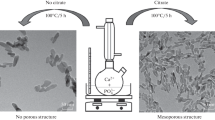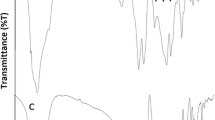Abstract
This investigation is inspired by multifunctional properties and biocompatibility of meglumine (ML) for new applications in colloidal processing of materials. The application of ML as both an alkalizer and capping agent enabled the fabrication of hydroxyapatite (HA) nanoparticles. The morphologies of HA nanoparticles prepared using ML alkalizer/capping agent or an inorganic alkali are compared. The use of ML allowed particle size reductions and offers multiple processing and environmental benefits. The feasibility of solubilization of alginic acid (ALH) biopolymer and glycyrrhetinic acid (GAH) drug in water using ML is demonstrated. For the first time, electrophoretic deposition (EPD) of ALH and GAH from their solutions is performed. The solubilization and EPD mechanisms are discussed, and the film deposition yield is analyzed. The use of ML as alkalizer, solubilizer, capping and dispersing agent facilitates the fabrication of ALH-GAH, ALH-HA, ALH-silica, and ALH-titania films by EPD. Changes in the EPD bath composition allows for the variation of the composition and microstructure of the films. The benefits of the suggested method for colloidal processing of composites are discussed. The use of ML opens an avenue for synthesis of other inorganic nanomaterials of controlled size, nanoparticle dispersion, solubilization, and EPD of other polymers, drugs, and composites.
Graphical abstract











Similar content being viewed by others
Explore related subjects
Discover the latest articles, news and stories from top researchers in related subjects.Data availability
The data that has been used is available.
References
Guo RY, An ZM, Mo LP, Yang ST, Liu HX, Wang SX, Zhang ZH (2013) Meglumine promoted one-pot, four-component synthesis of pyranopyrazole derivatives. Tetrahedron 69:9931–9938. https://doi.org/10.1016/j.tet.2013.09.082
Naeem D, Osman M, Maghraby GE, Ebtessam E (2020) Salt and non-salt forming excipients to improve the dissolution of dexibuprofen; formulation of chewable tablets. Eur J Biomed Pharm Sci 7:01–11. https://doi.org/10.13140/RG.2.2.16748.10883
Aloisio C, Gomes de Oliveira A, Longhi M (2014) Characterization, inclusion mode, phase-solubility and in vitro release studies of inclusion binary complexes with cyclodextrins and meglumine using sulfamerazine as model drug. Drug Dev Ind Pharm 40:919–928. https://doi.org/10.3109/03639045.2013.790408
Yamashita S, Fukunishi A, Higashino H, Kataoka M, Wada K (2017) Design of supersaturable formulation of telmisartan with pH modifier: in vitro study on dissolution and precipitation. J Pharm Investig 47:163–171. https://doi.org/10.1007/s40005-017-0310-3
Patel MS, Parekh JN, Chudasama DD, Patel HC, Dalwadi P, Kunjadiya A, Bhatt V, Ram KR (2022) Meglumine-promoted eco-compatible pseudo-three-component reaction for the synthesis of 1,1-Dihomoarylmethane scaffolds and their green credentials. ACS Omega 7:30420–30439. https://doi.org/10.1021/acsomega.2c03787
Dong L, Mai Y, Liu Q, Zhang W, Yang J (2020) Mechanism and improved dissolution of glycyrrhetinic acid solid dispersion by alkalizers. Pharmaceutics 12:82. https://doi.org/10.3390/pharmaceutics12010082
Aloisio C, Antimisiaris SG, Longhi MR (2017) Liposomes containing cyclodextrins or meglumine to solubilize and improve the bioavailability of poorly soluble drugs. J Mol Liq 229:106–113. https://doi.org/10.1016/j.molliq.2016.12.035
Fusina A, Degot P, Touraud D, Kunz W, Nardello-Rataj V (2022) Enhancement of water solubilization of quercetin by meglumine and application of the solubilization concept to a similar system. J Mol Liq 368:120756. https://doi.org/10.1016/j.molliq.2022.120756
Rundfeldt C, Klein P, Boison D, Rotenberg A, D’Ambrosio R, Eastman C, Purnell B, Murugan M, Goodkin HP, Loscher W (2023) Preclinical pharmacokinetics and tolerability of a novel meglumine-based parenteral solution of topiramate and topiramate combinations for treatment of status epilepticus. Epilepsia 64:888–899. https://doi.org/10.1111/epi.17520
Cassimiro DL, Kobelnik M, Ribeiro CA, Crespi MS, Boralle N (2012) Structural aspects, thermal behavior, and stability of a self-assembled supramolecular polymer derived from flunixin–meglumine supramolecular adducts. Thermochim Acta 529:59–67. https://doi.org/10.1016/j.tca.2011.11.030
Cassimiro DL, Ribeiro CA, Capela JMV, Crespi MS, Capela MV (2011) Kinetic parameters for thermal decomposition of supramolecular polymers derived from flunixin-meglumine adducts. J Therm Anal Calorim 105:405–410. https://doi.org/10.1007/s10973-010-1116-y
Cao XJ, Sun CR, Pan YJ (2003) The complex of flunixin and meglumine. Acta Crystallogr Sect E Struct Rep Online 59:o1471–o1473
Telang C, Mujumdar S, Mathew M (2009) Improved physical stability of amorphous state through acid base interactions. J Pharm Sci 98:2149–2159
Ferreira LM, Kurokawa SS, Alonso JD, Cassimiro DL, Souza ALRd, Fonseca M, Sarmento VHV, Regasini LO, Ribeiro CA (2016) Structural and thermal behavior of meglumine-based supra-amphiphiles in bulk and assembled in water. Langmuir 32:11878–11887
Sawamura T, Okuyama M, Maeda H, Obata A, Kasuga T (2016) Preparation of calcium-phosphate cements with high compressive strength using meglumine as a water reducer. J Ceram Soc Jpn 124:223–228. https://doi.org/10.2109/jcersj2.15249
Moradi L, Tadayon M (2018) Green synthesis of 3,4-dihydropyrimidinones using nano Fe3O4@meglumine sulfonic acid as a new efficient solid acid catalyst under microwave irradiation. J Saudi Chem Soc 22:66–75. https://doi.org/10.1016/j.jscs.2017.07.004
Deen I, Zhitomirsky I (2014) Electrophoretic deposition of composite halloysite nanotube–hydroxyapatite–hyaluronic acid films. J Alloy Compd 586:S531–S534. https://doi.org/10.1016/j.jallcom.2013.01.088
Hayakawa K, Okuno Y, Fujiwara K, Shimizu Y (1994) Effect of iodinated contrast media on ionic calcium. Acta Radiol 35:83–87
Motesadi Zarandi F, Alizadeh P, Kohoolat G, Kaviani A (2024) Novel multifunctional bioactive glass incorporated alginate/poly(amidoamine) hydrogels with controlled drug release for cartilage tissue regeneration. J Mater Sci 59:1550–1569. https://doi.org/10.1007/s10853-023-09275-9
Song Y, Hu Q, Liu Q, Liu S, Wang Y, Zhang H (2023) Design and fabrication of drug-loaded alginate/hydroxyapatite/collagen composite scaffolds for repairing infected bone defects. J Mater Sci 58:911–926. https://doi.org/10.1007/s10853-022-08053-3
Wei W, Chen F, Qiu Y, Zhang L, Gao J, Wu T, Wang P, Zhang M, Zhu Q (2023) Co-encapsulation of collagen peptide and astaxanthin in WG/OG/W double emulsions-filled alginate hydrogel beads: Fabrication, characterization and digestion behaviors. J Colloid Interface Sci 651:159–171. https://doi.org/10.1016/j.jcis.2023.07.201
Shi XW, Tsao CY, Yang X, Liu Y, Dykstra P, Rubloff GW, Ghodssi R, Bentley WE, Payne GF (2009) Electroaddressing of cell populations by co-deposition with calcium alginate hydrogels. Adv Func Mater 19:2074–2080
Sahoo DR, Biswal T (2021) Alginate and its application to tissue engineering. SN Applied Sciences 3:30
Prakash S, Kumari M, Chauhan AK (2024) The intervention of nanotechnology in food packaging: a review. J Mater Sci 59:2585–2601. https://doi.org/10.1007/s10853-024-09360-7
Caruso MR, D’Agostino G, Milioto S, Cavallaro G, Lazzara G (2023) A review on biopolymer-based treatments for consolidation and surface protection of cultural heritage materials. J Mater Sci 58:12954–12975. https://doi.org/10.1007/s10853-023-08833-5
Liu S, Li Y, Li L (2017) Enhanced stability and mechanical strength of sodium alginate composite films. Carbohyd Polym 160:62–70
Cheong M, Zhitomirsky I (2008) Electrodeposition of alginic acid and composite films. Colloids Surf, A 328:73–78. https://doi.org/10.1016/j.colsurfa.2008.06.019
Zhitomirsky I (2002) Cathodic electrodeposition of ceramic and organoceramic materials. Fundamental aspects. Adv Coll Interface Sci 97:279–317. https://doi.org/10.1016/S0001-8686(01)00068-9
Varshney S, Nigam A, Pawar SJ, Mishra N (2022) An overview on biomedical applications of versatile silica nanoparticles, synthesized via several chemical and biological routes: a review. Phosphorus Sulfur Silicon Relat Elem 197:72–88
Yin ZF, Wu L, Yang HG, Su YH (2013) Recent progress in biomedical applications of titanium dioxide. Phys Chem Chem Phys 15:4844–4858
Synthesis of glycyrrhetinic acid-modified chitosan 5-Fluorouracil nanoparticles and its inhibition of liver cancer characteristics in vitro and in vivo (2013)
Ma X, Jiang Y, Wen J, Zhao Y, Zeng J, Guo Y (2020) A comprehensive review of natural products to fight liver fibrosis: alkaloids, terpenoids, glycosides, coumarins and other compounds. Eur J Pharmacol 888:173578
Chu Y, Li D, Luo Y-F, He X-J, Jiang M-Y (2014) Preparation and in vitro evaluation of glycyrrhetinic acid-modified curcumin-loaded nanostructured lipid carriers. Molecules 19:2445–2457
Moradi L, Zare M (2018) Ultrasound-promoted green synthesis of 1, 4-dihydropyridines using fuctionalized MWCNTs as a highly efficient heterogeneous catalyst. Green Chem Lett Rev 11:197–208
Acknowledgements
This research was supported by the Natural Sciences and Engineering Research Council of Canada. Electron microscopy studies were performed at the Canadian Centre for Electron Microscopy.
Funding
Canadian Network for Research and Innovation in Machining Technology,Natural Sciences and Engineering Research Council of Canada,RGPIN-2018-04014,I. Zhitomirsky
Author information
Authors and Affiliations
Contributions
Rebecca Sikkema: Writing – original draft, Methodology, Investigation, Data curation, Writing – review & editing, Igor Zhitomirsky: Writing – review & editing.
Corresponding author
Ethics declarations
Competing interests
The authors declare that they have no known competing interests.
Additional information
Handling Editor: Stephen Eichhorn.
Publisher's Note
Springer Nature remains neutral with regard to jurisdictional claims in published maps and institutional affiliations.
Supplementary Information
Below is the link to the electronic supplementary material.
Rights and permissions
Springer Nature or its licensor (e.g. a society or other partner) holds exclusive rights to this article under a publishing agreement with the author(s) or other rightsholder(s); author self-archiving of the accepted manuscript version of this article is solely governed by the terms of such publishing agreement and applicable law.
About this article
Cite this article
Sikkema, R., Zhitomirsky, I. Application of meglumine for the solubilization of an alginic acid polymer and drug, the synthesis of hydroxyapatite, and the electrophoretic co-deposition. J Mater Sci (2024). https://doi.org/10.1007/s10853-024-10228-z
Received:
Accepted:
Published:
DOI: https://doi.org/10.1007/s10853-024-10228-z




